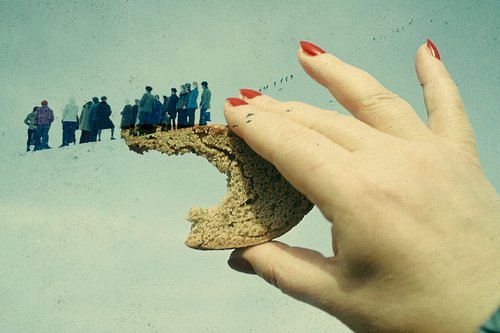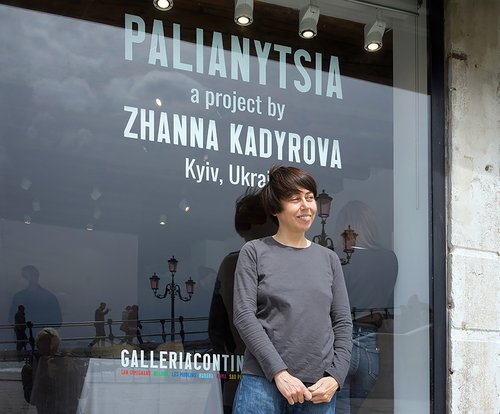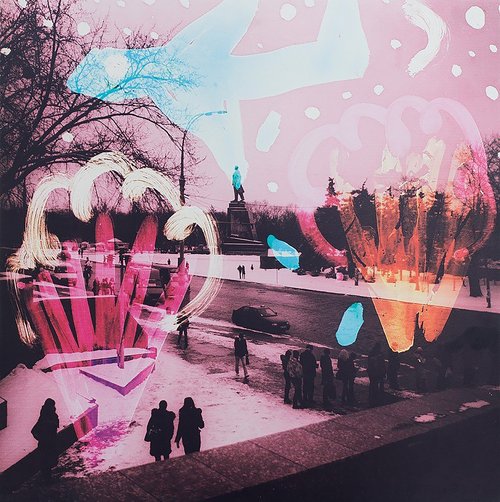Nikita Kadan grapples with ghosts of the Soviet past in Japan

Nikita Kadan. Stars of the Province, 2022. Courtesy of the artist
Kyiv-born artist Nikita Kadan has created a new site-specific installation and two solo exhibitions in Japan. In all three projects, as throughout his career, Kadan grapples with ghosts of the Soviet past.
A rocket and a satellite. Objects chewed by the toothless gums of time. Metallic objects of bent stainless steel that look like playgrounds from Soviet courtyards. This new installation by Ukrainian artist Nikita Kadan (b. 1982) in a cozy valley in Japan’s Echigo-Tsumari region serves as a startling monument to the failed Soviet project and its main symbol, the unexplored cosmos.
In early July, the young, dark-eyed artist, having temporarily escaped from his war-torn country, stood against the retro-futuristic outline of a Japanese power plant. He told local reporters about the monstrous crimes committed by Russian artillery, about the bombed pediatric oncology wing of a hospital in Kyiv, and he explained what lay behind the strange metal agglomerations he calls ‘Objects from Another Place’.
"Kyiv’s courtyards are littered with these Soviet playgrounds," Kadan began. "This quote from my childhood symbolises Soviet progress, glorifying peaceful space exploration, proposing the colonisation of other planets, and representing a dream. The genocide of Ukrainian people brought about by this war has changed the perception of the shared past of the former USSR republics. When I first created sketches of these melting rockets and satellites, they transformed before my eyes into something else. Losing their cosmic purpose, they lost their ideological integrity."
While the local Japanese journalists may not have fully grasped the problems of late Soviet modernism and the leftist discourse of post-Soviet intellectuals, they sympathise deeply with the children and victims of the war. From the very first days, Japan took the side of Ukraine, organising humanitarian aid programmes and welcoming a small number of refugees. Ukrainian news remains a staple on television, on metro screens too, even two years after the initial full-scale invasion. The Japanese express their sympathy ceremoniously and sensitively, listening silently, intently, not rushing.
I slip through the crowd of journalists; I too am an object from Another Place. In fact, we are both from that non-existent other place: born in the Ukrainian Soviet Socialist Republic, Kadan carries a piece of our shared past, since I too was “born in the U.S.S.R”.
As an artist, Kadan has established himself as an ideal representative in the field of so-called contemporary art, a label behind which late Eastern European modernism often hides. A graduate of the National Academy of Fine Arts in Kyiv (2007), he is part of the ‘Orange Revolution’ generation (2004), along with colleagues from the Revolutionary Experimental Space art group like Ksenia Hnylytska (b. 1984), Zhanna Kadyrova (b. 1981), Volodymyr Kuznetsov (b. 1976), Lada Nakonechna (b. 1981), and Lesia Khomenko (b. 1980). Indeed, it is thanks to Kadyrova, who exhibited at an earlier triennale in Japan, that there was already some prior knowledge of the experimental group’s activities in Kadan’s audience. In her ‘Palyanytsya’ project, Kadyrova offered viewers stone bread against a background of wailing sirens.
Kadan himself is, first and foremost, an excellent draftsman. But he is also a contemporary thinker. From the very beginning of his creative career, Kadan's works have been associated with the critique of violence and the power that generates this violence.
My attention was drawn to ‘Procedure Room’ (2009–2010), which explores medical themes through crafts. Visual instructions for prison tortures drawn in the style of illustrations from Soviet textbooks of the 1950s are printed onto porcelain plates. The fragility of porcelain and the fragility of the human body create a double meaning, further reinforced by the ability of glazed porcelain to impart a sense of alienation, sterility, and institutional indifference. However, unlike the Homeric laughter of Sots Art, the grim context of the unrelenting Soviet legacy of institutions of violence and power makes Kadan’s work resonate with a particular melancholy and a signature darkness.
Empty forms whose ideological content has lost its relevancy feature in almost all of Kadan's works, especially true for those which address the theme of war, which has occupied the artist since the annexation of Crimea in 2014. Kadan collects dystopian fragments of the Soviet past, which have experienced violence at the hands of the new Russian authorities, such as the distorted tin of car bodies in the statues ‘Gazelka’ (2015) and ‘Hostomel sculpture’ (2022). Total installations like ‘Shelter I’ (2015) and ‘Shelter II’ (2022-2023) recreate the atmosphere of a basement in a Soviet high-rise, replete with surreal inserts of symbols of hope and wisdom. In his ‘Stars of the Province’ (2022) sculptures, the fragments of coloured antique glass melted in the fire and blaze caused by bombing, resemble objects from the Hiroshima Peace Memorial Museum.
Interviewed by Larissa Babij in 2015, Kadan acknowledged that “narrated history” lies at the core of his work. This theme of memory and monument brings Kadan's works closer to the subtle and ironic imagery of Russian photographer Igor Mukhin’s (b. 1961) series ‘In Search of Monumental Propaganda’, or even to Lee Friedlander's (b. 1934) ‘The American Monument’ (1976), an equally important body of work on a similar theme.
Kadan’s art has resonated deeply in Japan. Two of his projects were the centrepiece of the 2024 edition of the Echigo-Tsumari Triennale: the installation ‘Objects from Another Place’ and an exhibition of works on paper ‘The Protection of the Joint Share’ at the Monet Museum in Tokamachi. Even Antony Gormley's (b. 1950) temple installation for the same triennale seemed inconsequential compared to the Kadan pieces. In fact, Kadan also led a Ukrainian symposium in Tokamachi, as well as opening a parallel solo exhibition, ‘The Dancers and Explosions’, at the Art Front Gallery in Tokyo.
Looking at ‘Newborn’, a series of photographs dedicated to the decay of a dead bird at the Art Front gallery exhibition, brings to mind the genre of Japanese painting kusōzu, which appeared during the Heian period (794–1185).
The genre served as an artistic response to an ancient Buddhist meditation practice, fujōkan, which requires monks to focus on images of a decomposing human body, in nine stages of decay from a fresh corpse to bare bones.
For dramatic effect, the model is most often a beautiful female body. First, it is covered with livor mortis, the skin becomes deformed, then scavenging animals eat the flesh, and so on. All of this, from a Buddhist perspective, should end the illusion of life in the mind of the meditator. However, the fact that the model is initially an attractive female body, a symbol of love and sexuality, changes the picture. The illusory nature of love, attraction, attachment also comes to the centre of the meditation.
Mindful of this, I ask myself, what does Kadan want to fall out of love with? Considering that his field of activity is public history, the answer is simple – ideology is illusory and should no longer be an object of our love.
Echigo-Tsumari Art Triennale 2024
Echigo-Tsumari Art Triennale 2024
Echigo-Tsumari, Japan
July 13 – November 11, 2024
Nikita Kadan. ‘Dancers and Explosions’
Tokyo, Japan
July 11 – August 18, 2024






























